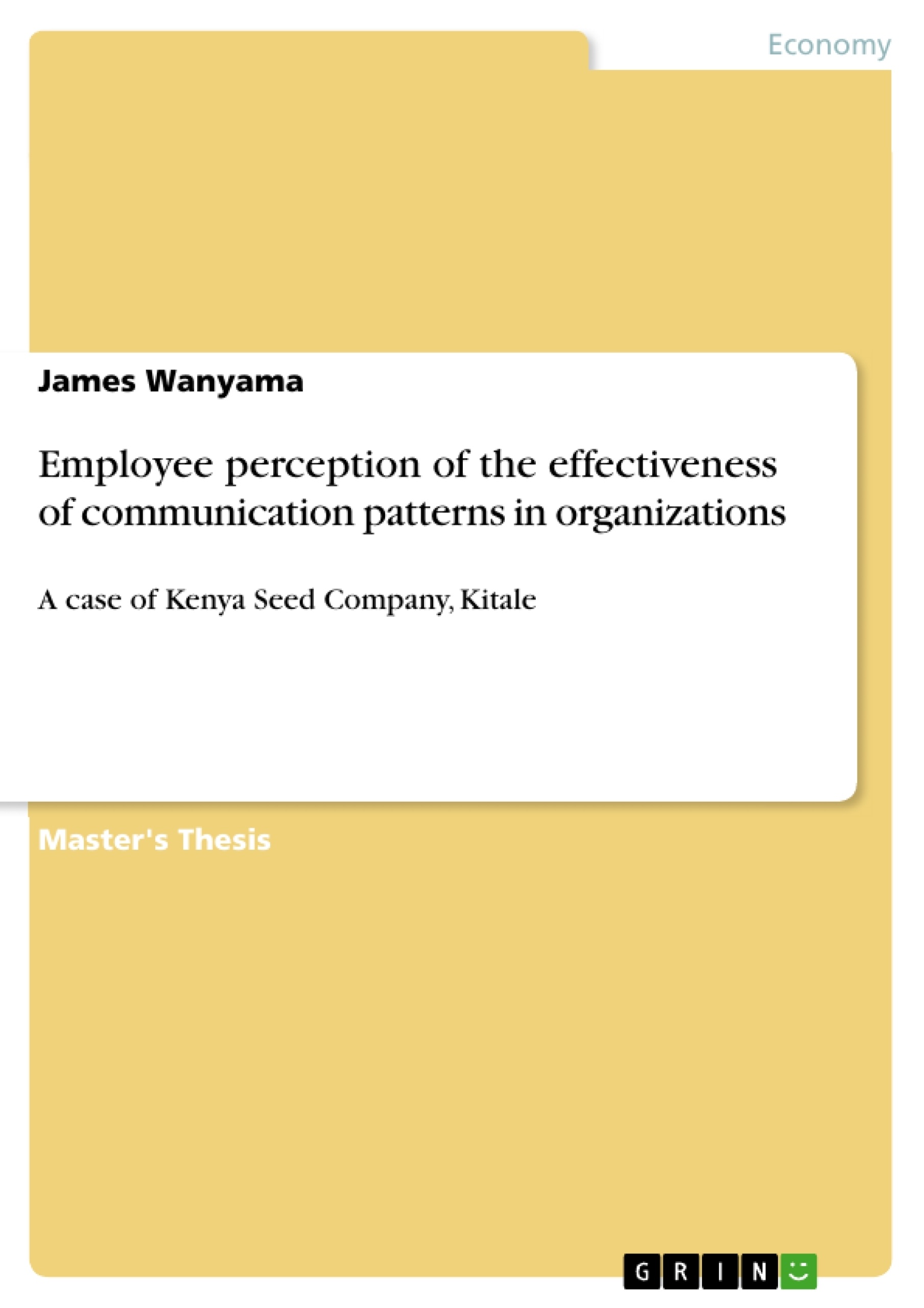A communication system links together the constituent parts of an organization and provides for the creation, distribution, interpretation and execution of instructions.
The purpose of the study was to investigate employees’ perception of the effectiveness of communication patterns used in organizations, establish employee use, evaluating and rating of the known patterns of communication, and how the known patterns are effective in service delivery.
This study was guided by the kite orientation model (1973), which focuses on interpersonal communication on communication that is two-way and emphasizes on the dynamics of communication situations. Related literature on this model, Human Resource Management and relationship between communication patterns and Human Resource Management was reviewed.
Survey research design was used and was carried out at Kenya Seed Company. There are over 300 employees from the departments of Human Resource, Public Relations, research and development, auditing and field, Marketing and Finance. Out of this, a sample of 180 which represented 60% from the whole population was selected using purposive and stratified sampling. Data was collected using questionnaires, observation and interview schedules. The data collected was then classified, presented, analyzed and interpreted through descriptive statistical techniques. The data was presented in the form of percentages and frequency tables.
The findings were that employees perceived the use of communication patterns as ineffective, and the study further suggested that organizations should put in place structures that will improve communication between employees and management.
The findings of the study will be useful to management of Kenya Seed Company as information will be provided as a benchmark to evaluate its communication patterns to enhance effectiveness in service delivery. The study will serve as an additional reference material for scholars interested in exploring the communication patterns as a broad aspect in the world and specifically in such organizations as Kenya Seed Company.
Inhaltsverzeichnis (Table of Contents)
- DEDICATION
- ABSTRACT
- TABLE OF CONTENTS
- LIST OF TABLES
- LIST OF FIGURES
- ACKNOWLEDGEMENT
- OPERATIONAL DEFINITION OF TERMS
- CHAPTER ONE
- 1.0 INTRODUCTION
- 1.1 BACKGROUND OF THE STUDY
- 1.2 HISTORICAL BACKGROUND
- 1.3 STATEMENT OF THE PROBLEM
- 1.4 OBJECTIVES OF THE STUDY
- 1.5 RESEARCH QUESTIONS
- 1.6 RESEARCH HYPOTHESES
- 1.7 SIGNIFICANCE OF THE STUDY
- 1.8 SCOPE AND LIMITATION OF THE STUDY
- 1.9 ASSUMPTIONS OF THE STUDY
- 1.10 THEORETICAL FRAMEWORK
- 1.11 CONCEPTUAL FRAMEWORK
- CHAPTER TWO
- 2.0 INTRODUCTION
- 2.1 HUMAN RESOURCE MANAGEMENT
- 2.2 MEDIA OF COMMUNICATION
- 2.2.1 Written communication
- 2.2.2 Oral communication
- 2.2.3 Non-verbal communication
- 2.2.4 Audio-visual media
- 2.2.5 Effective communication
- 2.2.6 Communication and organizational structure
- 2.3 DIRECTION OF COMMUNICATION FLOW
- 2.3.1 Downward Communication
- 2.3.2 Upward Communication
- 2.3.3 Horizontal Communication
- 2.3.4 The Grapevine
- 2.4 EMPLOYEE RELATIONS IN COMMUNICATION
- 2.5 COMMUNICATION AND THE ACHIEVEMENT OF OBJECTIVES
- 2.6 CONSULTATION AND COMMUNICATION
- 2.7 SUMMARY
- CHAPTER THREE
- 3.0 INTRODUCTION
- 3.1 RESEARCH DESIGN
- 3.2 STUDY AREA
- 3.3 STUDY POPULATION
- 3.4 SAMPLING PROCEDURES
- 3.5 DATA COLLECTION INSTRUMENTS
- 3.5.1 Questionnaires
- 3.5.2 Observation Schedule
- 3.5.3. Interviews
- 3.6. VALIDITY
- 3.7 RELIABILITY
- 3.8 PILOTING
- 3.9 PROCESS OF DATA COLLECTION
- 3.10 DATA ANALYSIS
- 3.11. SUMMARY
- CHAPTER FOUR
- 4.0 INTRODUCTION
- 4.1 DATA OF THE STUDY POPULATION
- 4.2 AWARENESS OF COMMUNICATION PATTERNS
- 4.3 PATTERNS OF COMMUNICATION
- 4.3.1 The patterns commonly Used
- 4.3.2 Employee involvement in Communication
- 4.3.3 The rating of communication patterns in the organization
- Employee perception of communication pattern effectiveness
- Impact of communication patterns on service delivery
- Employee use and evaluation of communication patterns
- Relationship between communication patterns and Human Resource Management
- The role of organizational structure in communication effectiveness
Zielsetzung und Themenschwerpunkte (Objectives and Key Themes)
This study aims to investigate employees' perceptions of the effectiveness of communication patterns in organizations. It seeks to understand how employees use, evaluate, and rate these patterns and how they impact service delivery. The study utilizes the Kite Orientation Model (1973) as its theoretical framework, focusing on two-way interpersonal communication and the dynamics of communication situations.
Zusammenfassung der Kapitel (Chapter Summaries)
Chapter One introduces the study, providing background information, the statement of the problem, objectives, research questions, hypotheses, significance, scope, limitations, assumptions, and theoretical and conceptual frameworks. Chapter Two reviews related literature on Human Resource Management, media of communication, communication flow, employee relations, and the achievement of objectives through communication. Chapter Three outlines the research design and methodology, covering study area, population, sampling procedures, data collection instruments, validity, reliability, piloting, data collection process, and data analysis. Chapter Four presents, analyzes, and interprets the collected data, focusing on the study population's awareness and use of communication patterns, and their evaluation of the patterns within the organization.
Schlüsselwörter (Keywords)
Employee perception, communication patterns, organizational effectiveness, Human Resource Management, service delivery, Kite Orientation Model, communication flow, employee relations, research design, data analysis, Kenya Seed Company.
- Quote paper
- James Wanyama (Author), 2016, Employee perception of the effectiveness of communication patterns in organizations, Munich, GRIN Verlag, https://www.grin.com/document/338222



